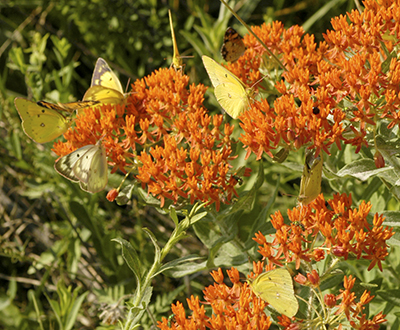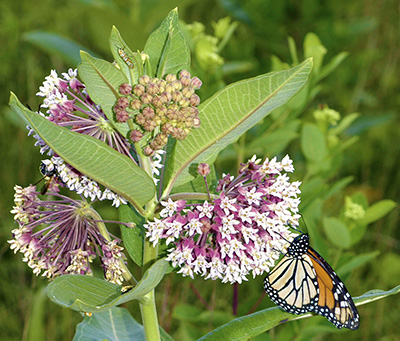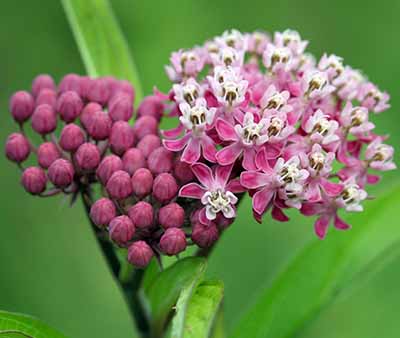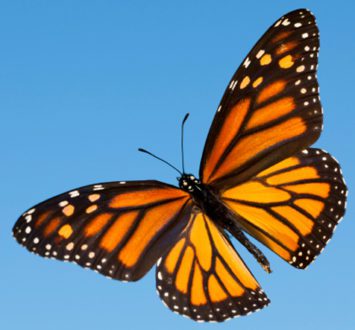Mar 7, 2018EQIP funds enhance monarch butterfly habitat
When you think of pollinators on your farm, your first thought might be about bees. However, monarch butterflies also pollinate many species of flowers and are readily recognized by most Americans. Paying attention to monarch populations is important because despite the huge amount of territory monarch butterflies cover during their migration back and forth to Mexico and as far north as portions of Canada, their numbers have dropped to the point where the U.S. Fish and Wildlife Service is considering a petition to list the species as endangered as early as 2019.
Why is this important to farmers? The Endangered Species Act has broad authority to restrict activity to prevent “take” (killing, harming, hunting/trapping or harassing) of an endangered species. This includes altering its habitat, which for an insect could include spraying for weeds, mowing, plowing, grazing or making other land use changes that would cause harm to an endangered species if it is found on your property. Even if it is not found on your property, any involvement with federal agencies, including easements, permits, farm bill program enrollment or others, could require consultation with the Fish and Wildlife Service for any lands in the species’ identified range. See “Endangered Species Listings Frequently Asked Questions” or “The Endangered Species Act” for more information.
Listing the monarch butterfly across its huge range (more than half the U.S., including Michigan) could severely restrict farm activity anyplace the butterfly is found. This is why Michigan Farm Bureau is working with the Michigan Department of Natural Resources, Michigan State University, Natural Resources Conservation Service (NRCS), Farm Service Agency, U.S. Fish and Wildlife Service and many other partners to develop a habitat management plan for the monarch butterfly. This habitat management plan, in coordination with other state plans, will be submitted to U.S. Fish and Wildlife Service to demonstrate that landowners, state and federal agencies, scientists and universities are committed to taking the actions needed to help the monarch recover without the need for listing under the Endangered Species Act and all the regulation that comes with it.
One way landowners and farmers can help is by participating in one of the pollinator protection programs offered by the U.S. Fish and Wildlife Service under the Conservation Reserve Program, and a new offering in Michigan from NRCS under the Environmental Quality Incentives Program (EQIP). Starting in 2018, NRCS will target financial assistance through the EQIPMonarch Habitat Initiative for implementing designated practices that create or improve monarch habitat. Some of these practices include conservation cover, field borders, prescribed burning and brush management. Eligible landowners may be able to receive financial assistance to offset the cost of establishing or improving pollinator and monarch habitat. Local NRCSconservationists will work with private landowners to create habitat for pollinators on farms, orchards and forests. Payment is provided after the practices have been installed and determined to meet NRCS standards.
The NRCS accepts applications for conservation financial assistance on a continuous basis. Applications may be submitted at local field offices or online using the Conservation Client Gateway. On designated dates, applications are ranked and selected for funding. The first ranking for 2018 applications was slated for January. Additional rankings may be held later in the year if funds are available. For more information on how to apply for financial assistance, contact your local NRCS field office.
Monarch butterfly populations have declined over the last several decades and are under consideration for listing as a threatened or endangered species. They have a remarkable life cycle, where in the fall they fly from Michigan all the way to the Central Highlands of Mexico to overwinter in large aggregations on fir trees at high elevations. The next spring, those very same individual butterflies return to the southern United States where they lay eggs on milkweeds before dying. Those eggs hatch to become caterpillars and eventually adult butterflies, which migrate the rest of the way back to Michigan, arriving in the spring. Several additional generations of monarchs breed in Michigan before repeating this cycle.
Monarchs require access to milkweeds, as these are the only plants that support development of the caterpillars. The most abundant milkweed in Michigan is common milkweed (Asclepias syriaca), which is found in old fields, pastures, roadsides and a variety of other disturbed habitats. Swamp milkweed (Asclepias incarnata), butterfly milkweed (Asclepias tuberosa) and whorled milkweed (Asclepias verticillata) are other common host plants for monarchs in Michigan. In addition to milkweeds for the caterpillar stage (larval), adult monarchs also must have plant nectar as a source of energy to fuel their flight and particularly need access to floral resources in the fall to power their long migration. So improving habitat for monarchs includes providing the necessary milkweeds and nectar plants that monarchs need to thrive.


Butterfly milkweed. Photo: Duke Elsner, MSU Extension


Common milkweed. Photo: Duke Elsner, MSU Extension


Swamp milkweed. Photo: David Cappaert, Bugwood.org.
Creating and improving habitat for monarchs can have other benefits as well. Aside from the economic incentive from the NRCS, monarch habitats will also support other pollinators including honey bees and wild bees that are necessary for pollinating many fruit and vegetable crops. These habitats can also support important predatory and parasitic insects that help suppress crop pests. Finally, creating monarch habitat may be a great public relations tool for growers who have a farm market or do other kinds of direct marketing, such as agritainment, or wineries with tasting rooms. Milkweed can be established in many niches on the agricultural landscape, including conservation and grazing lands, rights-of-way, field margins, and yard and garden areas.
Monarchs face a long journey from Michigan to Mexico and then back again, with many challenges along the way. By establishing or improving monarch habitat, farmers can play a key role in helping these important pollinators reach their destination.
– Mallory Fournier, Michigan State University Integrated Pest Management Program















